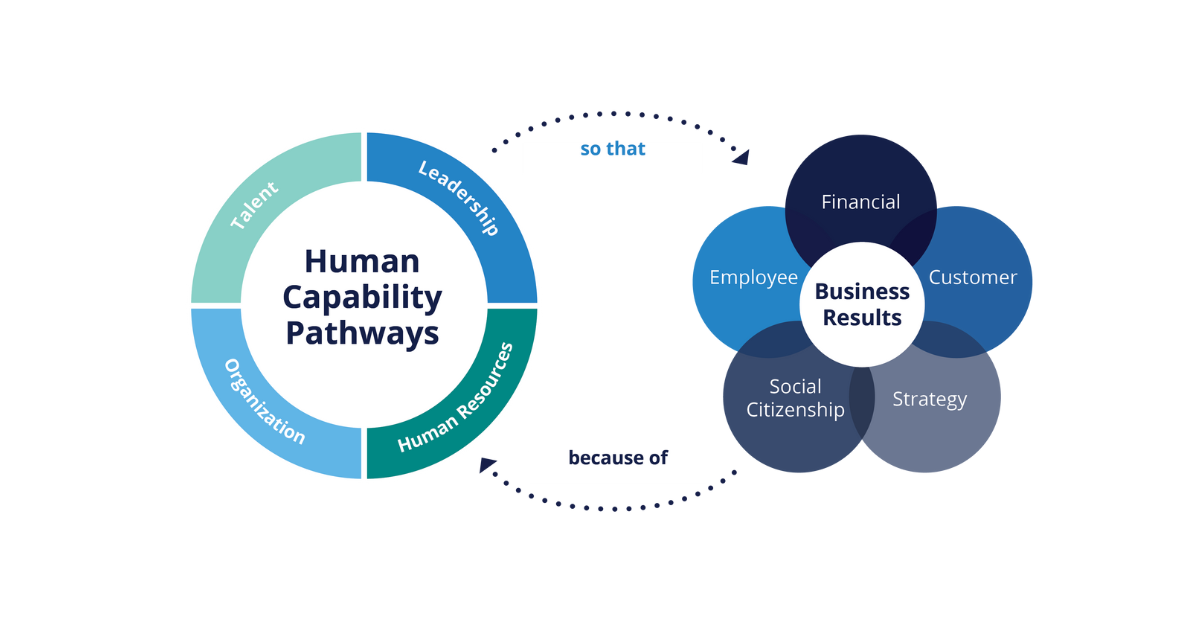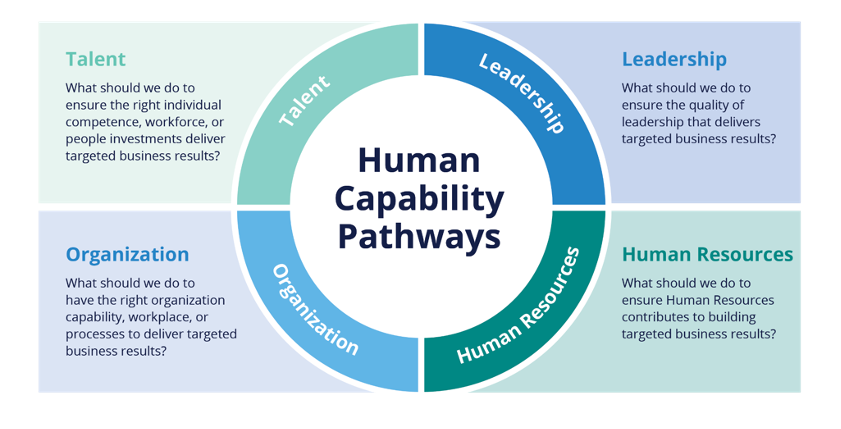Find Out Which Human Capability Investments Matter Most—Before You Invest
Key Take-Aways:
- Organizations often rely on a traditional methodology—benchmarking—to make decisions regarding what initiatives to invest in, which can result in the herd mentality of simply following what everyone else is doing.
- To truly determine which initiatives are likely to have the greatest impact on the organization, leaders need to start by identifying their own desired business outcomes.
- Once the desired outcomes are established, our Organization Guidance System provides prescriptive insight that changes the conversation from “what are others doing” to “what should we do” based on your unique target outcomes.

Find Out Which Human Capability Investments Matter Most—Before You Invest

How many different initiatives across talent, leadership, organization, and human resources (this is what we call “human capability investments”) is your organization currently working on? If yours is like most of the organizations we’ve worked with, each year you invest millions of dollars in scores of initiatives, both big and small, yet you don’t have a reliable way to judge the impact or return on time and dollars invested. Many of these initiatives are determined by benchmarking what other companies are doing.
The Problem with Benchmarking
Companies that wish to maximize organization effectiveness have traditionally relied on benchmarking. You compare yourselves to others in various categories and then, based on the benchmark data, either fix your weaknesses or build on your strengths by implementing the best practices for that situation.
The problem with benchmarking is that it only yields comparative industry data. How do you compare to other organizations and competitors? What can you do to be equal to others in your industry?
But benchmarking in and of itself does not yield insight into your unique business outcomes and what human capability investments would have the greatest impact. Of all the options highlighted by the benchmark data, what you really need to know before you move forward is which business outcomes will be impacted the most by alternative human capability investments. Not what you could do, but what you should do. Our Organization Guidance System was designed to give you that invaluable prescriptive insight.
Figure 1: Organization Guidance System Model

First, be clear about your needed business outcomes
To move beyond simply benchmarking, a better approach begins with focusing on the business outcomes you want to achieve. What are you as an organization trying to achieve? What business outcomes would have the biggest impact on your company? For example, do you want to increase profitability, improve employee engagement or increase customer satisfaction? Are you looking to strengthen your strategy or improve corporate and social responsibility (see Figure 2)?
Figure 2: Targeted Business Outcomes
.png?cb=0002)
Then, match your initiatives to your desired business outcomes
Based on what you are trying to achieve, we have identified four human capability pathways that can specifically impact your desired business outcomes. You can focus on:
- Talent
- Leadership
- Organization
- Human Resources
Figure 3: Human Capability Pathways

In the past, people have used the term “human capital.” We find this term limiting and have introduced the concept of “human capability,” which encompasses talent, leadership, organization, and human resources—which are all important in building the type of broad capability that impacts business results. Each human capability pathway is described above in Figure 3. You can link each of these pathways to targeted business outcomes and then identify the most critical initiatives in each pathway that will help you achieve the targeted outcome you desire.
To move away from determining what you are doing based on someone else’s business (i.e., benchmarking), we have developed a unique Organization Guidance System. This system starts by providing benchmarking baselines as references, which are nice to have, but then extends your analysis by providing specific guidance to address your unique outcomes and needs. The Organization Guidance System helps you (1) determine which initiatives in each pathway will enable you to improve your desired business outcome, (2) discover which investments are not likely to have the desired effect, and (3) make the precise adjustments required to achieve sustainable human capability improvement.
Why is the Organization Guidance System so valuable?
With this approach you know which human capability investments create the highest impact against targeted business outcomes. This lets you move beyond simply copying what others are doing that might drive their results to implementing initiatives that will drive your results. It shifts the discussion from identifying what others are doing to determining what you should do.
This prescriptive guidance for human capability investments is what drives so much value for you and your organization. The Organization Guidance System is a data-based diagnostic tool that tells you what to do to achieve the results you want and need. It lets you maximize organization investments and fundamentally transform how you can create value for your stakeholders.
The impact of implementing the Organization Guidance System can be profound.
An Organization Guidance System Case Study
Earlier this year we worked with a large healthcare company that was transforming a decentralized system of hospitals into one single system. They had already invested $10 million in the development of their senior executives. Now they needed help to take that leadership team to the next level.
Going in, they assumed their top improvement initiative would be to invest in additional leadership training. They opted to utilize the Organization Guidance System to test their assumptions. Working together, we determined that the primary business outcome they wanted to achieve was to improve patient results.
The Organization Guidance System then provided data and prescriptive insight regarding which people and organization investments had the greatest likelihood of achieving this goal of improving patient results. Interestingly, the Organization Guidance System showed that more leadership training would not achieve their goals. Rather, a focus on business case clarity and leadership reputation would have a more direct impact on patient results. In this organization’s case, the human capability investments that mattered most were not the ones they would have made if they had not used the Organization Guidance System.
Implications
The Organization Guidance System has shown the benefit of using data-driven, predictive guidance to implement initiatives that will get you to your ideal future.
Which human capability investments will have the greatest impact on your organization’s desired business outcomes? Explore how Organization Guidance System can help you answer this vitally important question.
